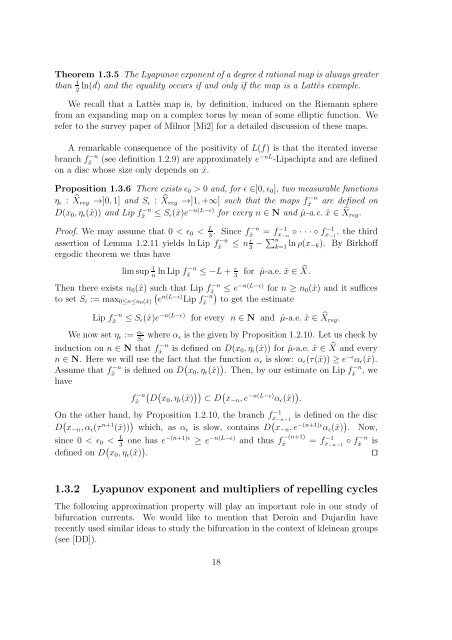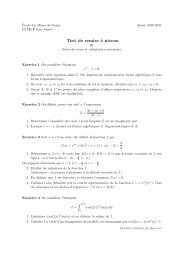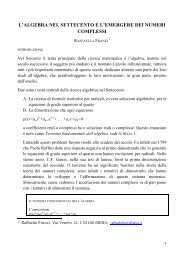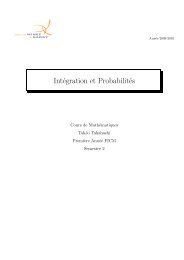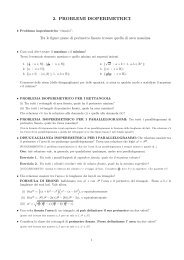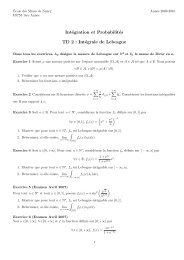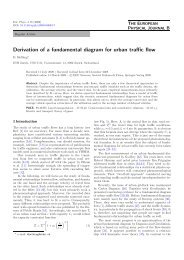Bifurcation currents in one-dimensional holomorphic dynamics
Bifurcation currents in one-dimensional holomorphic dynamics
Bifurcation currents in one-dimensional holomorphic dynamics
- No tags were found...
Create successful ePaper yourself
Turn your PDF publications into a flip-book with our unique Google optimized e-Paper software.
Theorem 1.3.5 The Lyapunov exp<strong>one</strong>nt of a degree d rational map is always greaterthan 1 ln(d) and the equality occurs if and only if the map is a Lattès example.2We recall that a Lattès map is, by def<strong>in</strong>ition, <strong>in</strong>duced on the Riemann spherefrom an expand<strong>in</strong>g map on a complex torus by mean of some elliptic function. Werefer to the survey paper of Milnor [Mi2] for a detailed discussion of these maps.A remarkable consequence of the positivity of L(f) is that the iterated <strong>in</strong>versebranch f −nˆx(see def<strong>in</strong>ition 1.2.9) are approximately e −nL -Lipschiptz and are def<strong>in</strong>edon a disc whose size only depends on ˆx.Proposition 1.3.6 There exists ɛ 0 > 0 and, for ɛ ∈]0, ɛ 0 ], two measurable functionsη ɛ : ̂Xreg →]0, 1] and S ɛ : ̂Xreg →]1, +∞] such that the maps f −nˆxare def<strong>in</strong>ed onD(x 0 , η ɛ (ˆx)) and Lip f −nˆx≤ S ɛ (ˆx)e −n(L−ɛ) for every n ∈ N and ˆµ-a.e. ˆx ∈ ̂X reg .Proof. We may assume that 0 < ɛ 0 < L −n. S<strong>in</strong>ce f3 ˆxassertion of Lemma 1.2.11 yields ln Lip f −nˆxergodic theorem we thus havelim sup 1 nln Lip f−nˆx≤ −L + ɛ 3≤ n ɛ 3 − ∑ n= fx −1−n◦ · · · ◦ fx −1−1, the thirdk=1 ln ρ(x −k). By Birkhofffor ˆµ-a.e. ˆx ∈ ̂X.Then there exists n 0 (ˆx) such(that Lip f −nˆx )≤ e −n(L−ɛ) for n ≥ n 0 (ˆx) and it sufficesto set S ɛ := max 0≤n≤n0 (ˆx) e n(L−ɛ) Lip f −nˆx to get the estimateLip f −nˆx≤ S ɛ (ˆx)e −n(L−ɛ) for every n ∈ N and ˆµ-a.e. ˆx ∈ ̂X reg .We now set η ɛ := αɛS ɛwhere α ɛ is the given by Proposition 1.2.10. Let us check by<strong>in</strong>duction on n ∈ N that f −nˆxis def<strong>in</strong>ed on D(x 0 , η ɛ (ˆx)) for ˆµ-a.e. ˆx ∈ ̂X and everyn ∈ N. Here we will use the fact that the function α ɛ is slow: α ɛ (τ(ˆx)) ≥ e −ɛ α ɛ (ˆx).Assume that f −nˆxis def<strong>in</strong>ed on D ( x 0 , η ɛ (ˆx) ) . Then, by our estimate on Lip f −nˆx, wehave( (f −nˆx D x0 , η ɛ (ˆx) )) ⊂ D ( x −n , e −n(L−ɛ) α ɛ (ˆx) ) .On the other hand, by Proposition 1.2.10, the branch fx −1−n−1is def<strong>in</strong>ed on the discD ( x −n , α ɛ (τ n+1 (ˆx)) ) which, as α ɛ is slow, conta<strong>in</strong>s D ( x −n , e −(n+1)ɛ α ɛ (ˆx) ) . Now,s<strong>in</strong>ce 0 < ɛ 0 < L <strong>one</strong> has 3e−(n+1)ɛ ≥ e −n(L−ɛ) and thus f −(n+1)ˆxdef<strong>in</strong>ed on D ( x 0 , η ɛ (ˆx) ) .= f −1x −n−1◦ f −nˆxis⊓⊔1.3.2 Lyapunov exp<strong>one</strong>nt and multipliers of repell<strong>in</strong>g cyclesThe follow<strong>in</strong>g approximation property will play an important role <strong>in</strong> our study ofbifurcation <strong>currents</strong>. We would like to mention that Dero<strong>in</strong> and Dujard<strong>in</strong> haverecently used similar ideas to study the bifurcation <strong>in</strong> the context of kle<strong>in</strong>ean groups(see [DD]).18


